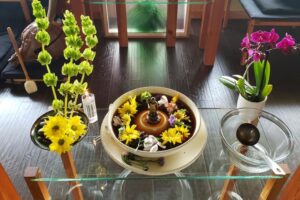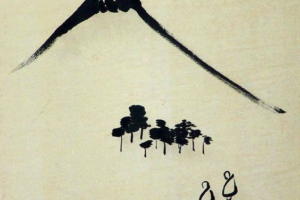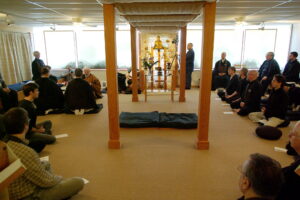
The following request was sent to me by one of our more senior members:
Gassho Sensei-san, Please write a bit about aging and practice… as I age my practice continues although I no longer chant much…but I would like to see what you have to say on the decline of some aspects of practice such as mindfulness, etc…. my practice of zazen helps with arthritis and tiredness which goes with both my illness and my aging… and my practice helps me relinquish what must be relinquished in age…
When anyone requests something specific, I recall a certain singer-songwriter who would always, in each performance, announce the request portion of the set; and then take suggestions from the audience. With each request, he would say he was sorry, he didn’t know that one. This would go on until the audience finally got it.
I think that what is mentioned above forms a good starting point. The well-known teacher Uchiyama-roshi, my dharma step-grandfather, had to stop doing zazen at a certain age, and took up chanting practice, from Okumuara-roshi’s account. Zazen is our saving grace, whether old or young; but can not be proven to be necessary. Most of us would have benefitted greatly from beginning at an earlier age, but better late than never. I am grateful that at my age I can still sustain a robust zazen practice, but I don’t know for how long.
Matsuoka-roshi declares that “Zazen keeps the men younger and the women more beautiful!” He knew how to sell water by the river to both genders. And I think he was talking about himself. He died at 85, but it was a young 85, in terms of his mind, though his body had failed him, owing to a stroke brought on by accident many years earlier.
He also said that when you do zazen, you always have a place to go. I don’t believe that he meant to imply that zazen is an escape from the realities of aging, sickness and death. But if you practice Zen, you have recourse to a method that always helps, no matter the slings and arrows that fickle fate hurls your way.
I also think it no accident that aging is listed first (skipping birth) in the three traditional cardinal dimensions of suffering for sentient beings. Sickness is related to aging, of course, as is death. But if you think about it, aging is omnipresent and timeless. Birth and death are inseparable. From the moment of conception, the aging process is in full force. In fact, aging can be accurately substituted for any of the other many descriptions of change: growing; maturing; evolving; and so on. Even before conception, aging is in full swing, as in the case of eggs aging in the fallopian tubes until they are no longer viable; or sperm in older men, suspected of being the origin of certain birth defects.
There is not a single thing on earth that has not aged considerably — 15 billion years or so and counting — unless you believe in biblical inerrancy. Any new birth is the product of vastly ancient ingredients that have come together through eons of causes and conditions, in infinite recombinant manifestations of living (and non-living) beings.
Zazen indeed provides sanctuary in the midst of change, necessary to dispassionately witnessing the deterioration of the body (and mind), and consider what the broader and deeper implications may be. It is difficult to be any blunter than to suggest “dying on the cushion.” But this is considered necessary to be able to live fully. What we have to relinquish with aging amounts to a punch-list of what we finally have to give up at death.
It is good to take a look at what we think constitutes our life, and what may be lost to death. One of the more obvious characteristics of a living being is breathing. There are creatures that hibernate and otherwise demonstrate a less than obsessive dependency on oxygen; anaerobic life-forms apparently thrive in the total absence of oxygen, but who calls that living? For a human or other sentient being, breathing is our lifeline. But it was not always so.
In the womb, the fetus does not breathe. Nutrients, including oxygen, enter through the umbilical cord. Imagine what that is like. Just try to remember. And why are we so fearful of suffocation, if we started out safe and sound in a fluid, amniotic sac? As an aside, it provides a good model of zazen to reduce the senses to their base level at that time: no sensation of temperature, and very little of sight and sound, let alone smell and taste. Not much to think about, or with. Sounds a bit like the “given emptiness…” section of the Heart Sutra.
When we sit in zazen, the breath slows down (the heart rate and other involuntary systems as well), the body becomes more still, the mind accords with deeper stillness. Must be similar, at least, to the actual process of physical death. This should not be a source of concern or anxiety, but perhaps best thought of as a kind of rehearsal.
Growing up with a series of pet dogs, cats, pigeons and other short-lived beasts, it occurred to me that one under-appreciated benefit is that they die before we do, usually. My grandparents, who hunted for deer as one aspect of their self-sufficent lifestyles, deep in the Missouri Ozarks, had a series of dogs, all named “Champ,” all the same breed. When they aged enough to know that another iteration of Champ would most likely outlive them, they did not get another. In retrospect, this seems a pragmatic act of extreme kindness and compassion for the dog, who would probably not be adopted by another family, in mid- to old-age. I understand that the Pharoahs and other worthies of the past would often be buried with animals, including in some cases their spouses and slaves. Not as compassionate as Grandpa Jim, but perhaps just as practical. Any survivors of the regime might have loyalty issues, at that level of society.
So it seems that the grief that we experience when a pet dies is indeed a kind of rehearsal. Just a way of getting ready, as I penned in an early attempt at songwriting. When we suffer grief, there is a kind of purity, of truth, to it. When we are closer to death, we inevitably come closer to the meaning of life. I am told that monks and nuns in Buddhism’s countries of origin would vie with each other for the privilege of serving at death-bed watches, help perform funerals, and even meditate in the bone-yards. Being close to death on a regular basis prepared them for the inevitable. And put a new perspective on life.
This should not be regarded as a morbid preoccupation, rather it is a realistic engagement on the indelible marks of emptiness — impermanence, imperfection, and insubstantiality.
As to sickness and death, the argument may be made that they are also universal and absolute. Health is a relative condition of sickness, and vice-versa. Death is moment-by-moment on cellular and other levels. How much of this body is alive; how much dead? By weight, for example? We lead ourselves astray by first creating — and then coming to believe in — these differences without a distinction.
In zazen, these conventional views, and the revulsion that ordinarily accompanies them, come under the withering light of the Zen Mirror. We can begin to see the process of dying and decaying, as in dementia and Alzheimer’s disease, as running the tape backwards, to the beginning.
There was an original poem attached to the message, which I would like to share with you:
Having assayed the depths of suffering —Everything is always alright! Even in the most momentous hurricane —not one leaf falls to the ground! There is not much cunning in my greeting —except as much as would lead you to consider the freshness left by the rain…*
A beautiful poem, I think, and hopeful, but perhaps leaving out the rest of the story. If it is true that we die on the cushion, it may be said that we have assayed the depths of suffering, at least on the personal level. I would add my poor words:
The depths of suffering hardly begin with death —Everything is always as it has been and will be! Do not imagine that you are not in the hurricane simply because the eye is calm —every leaf without exception finally falls! Cunning is useless; greeting the old friend in front of your face —the fresh rain tastes like ambrosia…
* Poem by Kokyo David Edgar Young, Pictou, Nova Scotia, Canada








